Somewhere deep in space, three galaxies find themselves entangled in all sorts. Pushing, pulling, and merging, these galaxies make a spectacular galactic dance.
Astronomers eyed at least three galaxies in a dramatic collision. They used data from NASA's Chandra X-ray Observatory, ESA's XMM-Newton, and three radio telescopes to "untangle" the mystery of these galaxies.

Massive Galaxy Cluster
These kinds of collisions and mergers are the primary mechanisms by which galaxy clusters might expand into the enormous cosmic structures we observe today. They serve as the biggest particle accelerators known to exist, according to NASA.
Abell 2256, a massive galaxy cluster that is developing as a result of this collision, is situated 780 million light-years from Earth.
This composite image of Abell 2256 combines radio data from the Giant Metrewave Radio Telescope (GMRT), the Low Frequency Array (LOFAR), and the Karl G. Jansky Very Large Array (VLA) - all represented in red.
X-rays from Chandra and XMM are represented in blue, while optical and infrared data from Pan-STARRs are shaded in white and pale yellow.
Some of the largest objects in the universe are galaxy clusters, which comprise hundreds or even thousands of individual galaxies. They also have vast gas reserves that are extremely hot, with temperatures reaching several million degrees Fahrenheit.
NASA said that this heated gas can only be seen by X-ray telescopes like Chandra and XMM.
However, the third galaxy cluster's gas is blended too closely with the other two to be distinguished in the labeled version of the image.
Read Also : NASA'S Hubble and Chandra Xray Revives a Dead Star Back to its Original Form Before its Violent Explosion
Radio Emission
This system's radio emission comes from a more intricate combination of sources. The first is the galaxies themselves, whose supermassive black holes at their centers produce the radio signal by ejecting particles in jets.
These jets are either slowed down as they engage with the gas they are rushing into to form intricate forms and filaments, or they are blasting into space in straight, angular lines.
Additionally, radio waves are coming from enormous filamentary structures, which are mostly found to the north of the radio-emitting galaxies.
NASA said that these structures were likely produced when the collision ejected shockwaves and propelled particles in the gas over a distance of nearly two million light-years.
The Astrophysical Journal's March 2022 issue contains research by Kamlesh Rajpurohit from the University of Bologna that examines this structure. The paper is online and was released earlier this year. It is the first in a series that examines many facets of this galaxy cluster system.
The collision's focal point was also surrounded by a "halo" of radio emission. Another radio image has been created to highlight the weak radio emission since this halo overlays the X-ray emission and is fainter than the filamentary structure and the galaxies.
Related Article : NASA's Chandra X-Ray Telescope Gives a Breathtaking Collection of Cosmic Bodies You Only See on Sci-Fi Movies

ⓒ 2025 TECHTIMES.com All rights reserved. Do not reproduce without permission.




